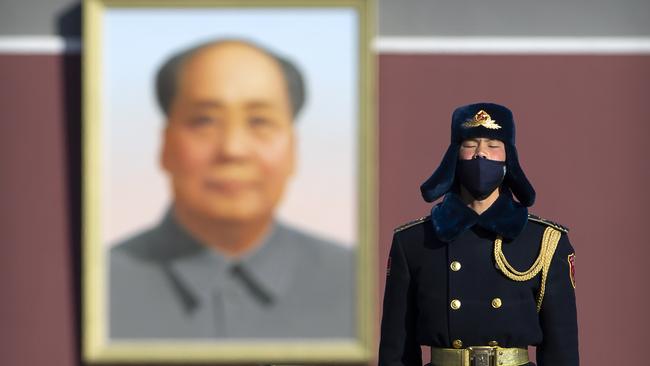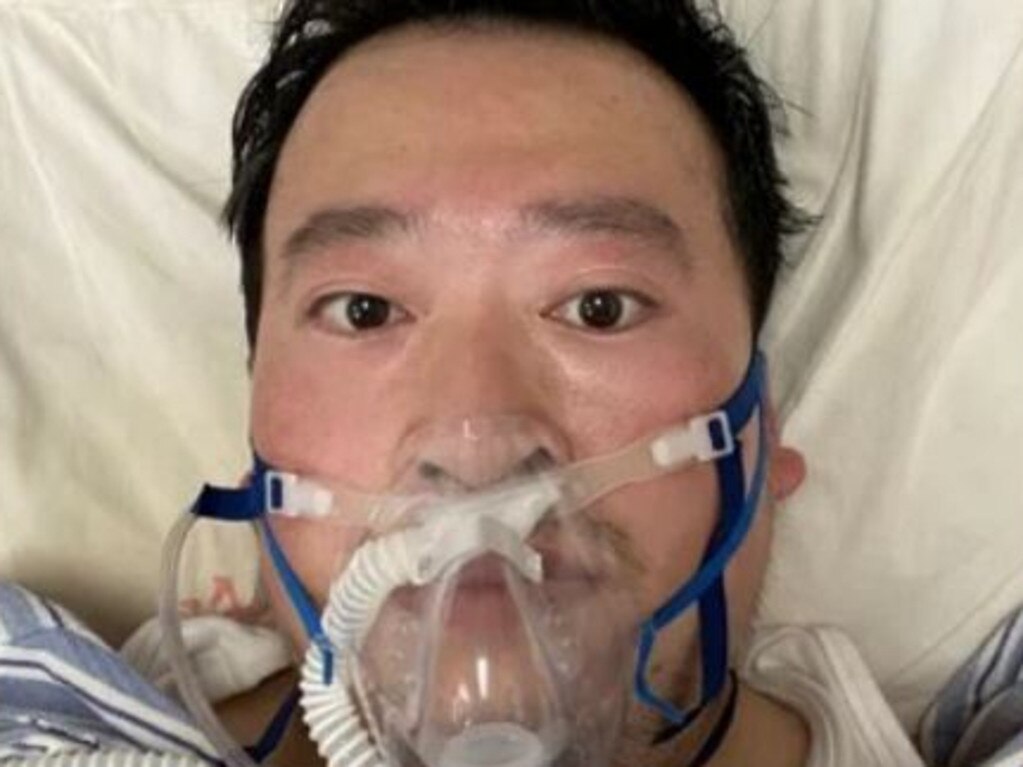Coronavirus: Facing a deadly demon, Xi Jinping’s China shows its true colours
Sometimes disasters illuminate a society’s weakness. Here are 10 lessons the coronavirus epidemic has taught us about China.

China’s leader Xi Jinping, an atheist with a penchant for religious language, calls coronavirus “a demon”. And who would disagree as its death toll keeps ticking up: so far 635 in China, already 286 more than during the severe acute respiratory syndrome epidemic that started in Guangdong province in 2003.
The ruling Communist Party’s flagship publication People’s Daily declared this week a “People’s War” against the virus — although the paper failed to publish a single word about the epidemic as it raged through Wuhan from January 1 to 20, while the authorities chose to downplay the issue. During that period it ran 66 articles with headlines lauding Xi.
Crises can bring out the best in countries, especially in local communities. That’s something we know well in Australia, amply proven this terrible fire season. We must honour the courage of the health workers in Wuhan, on the frontline of this war with a deadly demon. But sometimes disasters illuminate a society’s weaknesses.
Following are 10 lessons about the People’s Republic of China to be learned from this epidemic.
1. China is globally enmeshed. It cannot easily be quarantined. “When France sneezes, Europe catches cold,” it was said two centuries ago. That’s true today of China and the world. And not just medically. For a decade China has been the strongest engine of global growth. Gavekal Dragonomics co-founder Arthur Kroeber, a leading expert on the Chinese economy, warns that many indicators are likely to post double-digit negatives in the first quarter of 2020 — with “the obvious victims” outside China being tourism and the oil price.
Kroeber says: “This episode will reinforce views that China is in some ways an unreliable member of the global system, and that this unreliability is rooted in its opaque and authoritarian political system.” Thus the crisis will dent China’s capacity to export its development model and push multinationals to diversify their frequently China-centred supply chains. China’s growth this quarter may sink to 4 per cent or less.
2. The political structure under Xi has become more party- focused, more personalised and more centralised. And those lower in the structure are typically accountable only to those above them. This makes people in senior regional positions less likely to back themselves by making decisions, and more likely to prevaricate or defer to higher authorities elsewhere. The contagious disease law empowers the central government’s health department — not medical experts on the ground — to authorise public information on epidemics.
On January 26 the appointment was announced of a “Central Leading Small Group for Work to Counter the New Coronavirus Infection Pneumonia Epidemic” — positioning the management of the crisis within the “leading small groups” Xi has developed to frame and drive his policies, and thus beyond routine party or government structures.
Premier Li Keqiang is chairing this new coronavirus group, with the party’s propaganda and ideology guru Wang Huning as his deputy. None of the nine members is a health expert.
For a fortnight Xi has been portrayed as “commanding China’s fight” against the epidemic, “personally directing and planning everything”, but he has not visited the epicentre, Hubei province — possibly from concern the now indispensable Paramount Leader might be infected, or to provide him the room to blame those below if events deteriorate further.
3. The media is coming under increasingly heavy-handed control. This diminishes its capacity to warn the public of dangers — a role the party tends to view as troublemaking. Even Hu Xijin, editor of the nationalistic Global Times, has written: “The local government’s tolerance level of different online voices is way too low.” Eight doctors who were whistleblowers on social media in December were summoned by Wuhan police before being cleared following a Supreme Court intervention.
On Monday, China’s most powerful body, the politburo standing committee, urged authorities to “strengthen internet and media control … The outbreak is a major test of China’s system and capacity for governance”; 300 vetted journalists were dispatched to Wuhan to write “positive” stories.
Amnesty International regional director Nicholas Bequelin says: “The Chinese authorities’ insistence on controlling the news narrative and stifling negative coverage has continued to drive censorship of sometimes legitimate information about the virus,” although reporters, especially from financial publisher Caixin, Beijing Youth Daily and Beijing News, have battled to get the truth out. During the continuing enforced holiday, netizens are focusing on their smartphones as never before, reposting news, comments and photos before they are deleted by the authorities.
4. The health sector’s hands are tied. China’s strong restrictions on charities, temples or churches operating in the health sector, including training medical workers, limit its capacity to expand its care to meet demand as the population rapidly ages. The heartfelt, rapid response of citizens and social groups to the devastating Sichuan earthquake in 2008 greatly lifted the victims’ morale and the mood in the whole country. But this citizen-led altruism was consigned to memories as the People’s Liberation Army and the party were instead exalted as the heroes of the hour. What might have become a model for a new spirit of co-operation, available for enlistment in emergencies including epidemics — echoing Deng Xiaoping’s opening of the economy to business — has gone nowhere.
5. Centralisation is increasing. China has fine medical staff and equipment, but the sector is organised in a typically centralised manner. People with a common cold, a rash, a migraine or a sprained wrist join the queues at city hospitals. General practice clinics are extremely rare. This acts as a disincentive to the sick to be checked out, guarantees long queues and exacerbates the risk of cross-infections. Highly competent Chinese health scientists who have recently published coronavirus research in top global medical journals — in part because they were censored at home — have come under attack, including on social media from unofficially licensed pro-party “truth guards”.
6. Xi personally, and the party generally, remain popular as China’s prosperity continues to grow. But broader trust in official institutions is often withheld by the so-called Laobaixing, ordinary folk, especially in local authorities, which often cop the blame along the lines of “if only Xi knew”. This will be the case in Wuhan as it becomes more widely known the first coronavirus case was reported on December 8 but the public was not informed until December 31. Even then, the city failed to report a single new case as cadres met for annual sessions of the People’s Congress, while on January 19 the Wuhan local government organised a huge Chinese New Year banquet for 40,000 families and on January 21 — just two days before the city was closed — a variety show for officials.
7. The economy is stronger. China can enlist vastly more resources to tackle coronavirus than it could SARS in 2003 — its economy is almost nine times larger and 10 times more people are online. Back then China drove about 5 per cent of global trade; today it is 12 per cent.
Mark Tanner, founder of Shanghai-based market strategists China Skinny, anticipates pent-up demand may drive a bounce-back after the virus threat passes: “Well-marketed foreign goods could benefit, as the cleanliness, safety and healthiness of imported products is reinforced. Tourism, education and even migration may also rise as Chinese seek safer places to travel, study and live.” Car sales could boom as travellers seek to avoid crowded public transport.
8.Health reforms please some. The PRC is enjoying considerable success in “reforming and developing the global governance system” as urged by Xi at the last national party congress. The World Health Organisation is a model of such success. Director-General Tedros Ghebreyesus, lauding China’s response to the epidemic, heaped particular praise on Xi after their recent meeting in Beijing, for his “detailed knowledge of the outbreak”.
In contrast, Curtin University emeritus professor John Mackenzie, a member of WHO’s emergency committee, said, “on some of the more public health-type issues, they (the PRC authorities) have been rather recalcitrant”. WHO has kept Taiwan out of its public health loop, insisting it is called Taipei and should be treated as a province of the PRC.
9. Online services are improving. A Shanghainese blogger points out that sealed-off Wuhan is being sustained, while its public services have ceased or become severely stretched, by “an advanced network of internet-based service providers and mobile-organised support groups that were non-existent in 2003”. Among them, Alibaba’s online shopping platform, Didi’s mobile taxi service, SF’s logistics including courier services and Meituan’s food delivery.
10. Support is everything. Australians may be reminded by this crisis that despite criticisms of its handling by the authorities, China and the Chinese people are not identical with the party that rules it and them, and that those suffering there from the terrible impact of coronavirus merit our full empathy and support.
Rowan Callick, twice a China correspondent for The Australian, is an Industry Fellow at Griffith University.







To join the conversation, please log in. Don't have an account? Register
Join the conversation, you are commenting as Logout